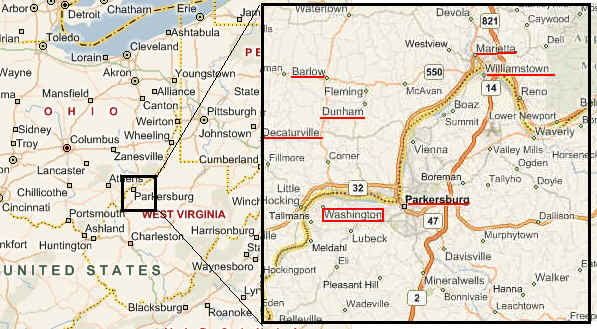June 22, 2007 mariettatimes.com
Testing for C8 could expand: Marietta and
Williamstown's water possibly next on EPA's list
The first phase of a new C8 contamination survey that
could lead to water in Marietta
and Williamstown being tested for the
chemical is now under way.
Neither municipality's water system has been tested for the
chemical, which was reported last year by the federal
Environmental Protection Agency as "likely"
carcinogenic to humans. The EPA's review is ongoing.
DuPont maintains that to date there are no health effects known
to be associated with C8.
The new testing by DuPont focuses on private wells in parts of
Barlow, Belpre, Decatur, Dunham and Warren townships and other
areas. It is part of an Order on Consent agreement between the
company and the EPA and is motivated, in part, by preliminary
results of a health screening that shows Ohio and West Virginia residents living
near the plant have 25 times more of the chemical in their blood
than the average population.
If C8 is detected in private wells, DuPont could be required to
filter the water, as is happening in six water districts south of
Marietta.
There is currently no requirement for any public water service to
test for C8, also known as ammonium perfluorooctanoate or PFOA.
Since the 1950s, the chemical has been used at DuPont's Washington Works plant near
Parkersburg in the production of Teflon and a variety of other
products.
Marietta is about 18 miles northeast of the DuPont plant.
DuPont spokeswoman Robin Ollis said part of the agreement
requires the company to test private drinking wells.
Depending on the levels and location of C8 detected in the first
phase of the project, the study could move into a second phase,
which is slated to include wells
and water systems in the Marietta and
Williamstown areas.
"If the resident's private water system contains (C8) equal
to or greater than 0.5 parts per billion, we will be required to
provide filtration or some other alternative," Ollis said.
About 100 private drinking wells are being tested as part of the
first phase of the project. Future studies are dependent on the
concentrations of the chemical in the current study.
The complete results from the first phase of the study will be
made available in a report due to the EPA early next month.
Ollis said DuPont sent out more than 8,000 letters to area
residents concerning the current study. She said because there is
no inventory of private drinking wells, the company was forced to
send notification to everyone in the test area, which was
established by the U.S. EPA.
"We have no way to know if an individual residence has a
drinking water well or another source," Ollis said.
Initially, testing for the DuPont chemical was only performed
within two miles of the local plant.
Last year, traces of C8 were found in a spring near Williamstown;
however, those levels were barely detectable in the parts per
trillion range.
http://www.mariettatimes.com/c8/index.html
C8 has been detected in several public water systems near
the Washington, W.Va.,
DuPont plant that has used and emitted the substance through its
manufacturing process for 50 years. The discovery of the chemical
in local water supplies in January 2002 prompted several
government investigations into the possible health risks of the
chemical.
C8 is a key ingredient in the process of manufacturing the
non-stick substance known as Teflon.
DuPont officials contend that over five decades of handling the
chemical, they have found no harmful health effects for humans.
However, their claim is being contested in the Wood County
Circuit Court where people who have the substance in their
drinking water and fear its potential danger have filed a class-
action lawsuit.
C8 has been detected in Little Hocking test wells in the amounts
of 50 and 78 parts per billion, which is much higher than any
other place. Little Hocking water customers routinely receive
about 2 parts per billion in their water.
『Environmental Science & Technology』誌に発表された記事(2004
年6 月23 日付け)
題名: PFOA
に発ガン性があるとの主張に対して、DuPont
社は異議を唱えている
化学品業界の巨人であるDuPont
社は、「ウエストバージニア州にある同社工場の一つではテフロン及びその他のフッ素ポリマーを製造しているが、その製造工程で使用されるPFOA
に曝されることにより、ガンになるリスクが増大する」という最近の研究発表に対して異議を唱えている。同社は、「工場作業者及び近隣住人の飲み水にはパーフッ素化合物が含まれており、彼らがガンに罹る割合は一般のそれよりも数倍高い」という研究に対して反論している。
PFOS
は、かつて繊維の撥水剤として有名だったスコッチガードを製造するときに使われたが、PFOS
同様にPFOA も人間の住んでいる環境に微量ながらも普遍的に存在している。これらパーフロロアルキル酸がどうやって人体に取り込まれるのかについては、大学の化学者、業界関係者、米国環境保護庁(EPA)によって鋭意調査が行なわれている。PFOA
は動物にガンを引き起こすことが知られているが、PFOA
に曝された工場作業者に関する研究では、ガンにつながる明白な証拠は見出せていない。昨年公表されたEPA
によるPFOA のリスクに関する予備調査によれば、女性の血液中に含まれている現在のPFOA
レベルでは胎児の発育に問題がでる可能性がある。
EPA
はこの夏までにもっと突っ込んだリスク調査結果を公表する予定。
しかしこのケースにおける発ガン性に対する懸念は、PFOA
の世界的な拡散によってではなく、もっと狭い地域における拡散によるものである。DuPont
社のオハイオ川に面したワシントン工場ではC8 と呼ばれるPFOA を50
年以上にわたって使っている。このほとんどの期間において、DuPont
社はPFOA
を大気中に放出したり近隣に廃棄したりしてきた。プラントの周りの地下水もパーフロロ酸を含んでいるが、ワシントン工場周辺の地下水中のPFOA
濃度は1ppb から8ppbでしかなく、これはウエストバージニア州が2002
年に設定した、懸念されるレベルである150ppbよりもかなり低い。
このウエストバージニア州の研究はロサンゼルスにあるカリフォルニア大学の毒物学者であるJames
Dahlgren 氏によって行なわれた。同氏はDuPont
社に対して集団訴訟を起した原告の代理人である。この2001
年の訴訟において原告が主張しているのは、「DuPont
社は知っていながらPFOA
を近隣の水系に放出し、またPFOA
が健康に良くないことを知っていた」というものである。Dahlgren
氏はこのデータをチェコのプラハで今年4
月に行なわれたthe Society ofEnvironmental Toxicology and
Chemistry という学会で発表した。
Dahlgren 氏らは、3
つの異なるグループにおけるガンの発現性について比較を行なった。これは、ウエストバージニア州にあるDuPont
社のWashington 工場近隣に住む599
人に対する調査、訴訟を通して入手した5,000
人のDuPont 社従業員の健康に関する内部資料、及び米国全土における発ガン性データを比較したものである。集団訴訟には、飲料水1
リットル中にPFOA が少なくとも0.5mg 混入している場所に少なくとも1
年以上住んでいるような、工場の近隣住民も含まれている。
Dahlgren 氏らは、近隣住民及びDuPont
社従業員の間では同じようなガンの発現率が高いことを見つけた。若い女性での前立腺ガン及び女性全般における子宮ガン及び子宮頸部ガンである。同氏らはまた、非ホジキンリンパ腫、白血病及び多発性骨髄腫といった珍しいガンの発現率が高いことも発見した。
Dahlgren
氏曰く、「若い女性におけるガンの種類とその発現率は、PFOA
に曝されたことを示している。またこれらのガンは若い女性及び40/50
代の女性には珍しいものである。これらホルモン攪乱タイプのガン(前立腺ガン・乳ガン・子宮頸部ガン)は、過去パーフッ素化合物に晒された工場労働者を調査したときにも見られたものである。PFOA
以外のファクターも可能はあるが、それよりもPFOA
や他のパーフッ素化合物である可能性の方が高いだろう」
この主張に対してDuPont 社のエピデミオロジスト(疫学者)であるRobin
Leonard
氏は、「同氏の説には科学的な裏づけがなされていない。例えばこの研究では、発ガン性に影響を与えると思われる他のファクターを制御しておらず、それに対する考慮や分析がなされていない」と反論している。
DuPont 社は100
万ドルをかけて、自発的に手を挙げたワシントン工場の750
名の従業員に対するPFOA
の影響調査を行なっているところである。その目標とするところは、PFOA
を使用しているテフロン部門の従業員と、同じ工場内にある他部門の従業員の結果を比較することである。
PFOAに関する基本情報
(EPA)
情報源:Basic Information on PFOA
Last updated on Wednesday, July 13th, 2005
2003年4月、EPAは化学物質PFOA(パーフルオロオクタン酸)の予備的リスク評価を発表した。その評価は、PFOAの潜在的な発達毒性に対する懸念及び一般のアメリカ人が非常に低レベルのPFOAに暴露しているかもしれないという情報に的を絞ったものであった。多くの不明であったデータがEPAによって特定されが、その多くは暴露範囲と暴露経路に関するものであった。EPAの現在の作業は、それらのデータの欠如を埋めること及びもっと頑強なリスク評価を完成させることである。完全な評価は、潜在的なリスクを低減するために追加的な規制措置が必要かどうかEPAが決定するために役に立つ。
PFOAに関連する懸念は何か?
PFOAは環境中で非常に残留性があり、環境中及び一般のアメリカ人の血液中に非常に低濃度で見いだされている。研究によれば、PFOAは実験動物に発達障害やその他の有害な影響を引き起こすことがある。PFOAはまた、人間の体内に長い間残留するように見える。これら要素の全てを総合して、現在見出される濃度で、又は今後PFOAが環境中に放出され続けて将来達するであろう濃度で、PFOAが人間の健康と環境にリスクを及ぼすかどうかをEPAは早急に調査する必要があると判断した。
|
